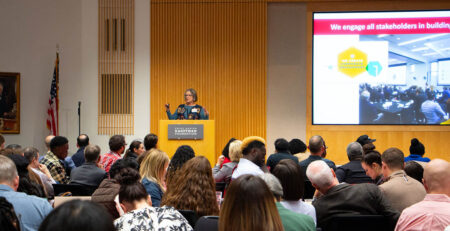Find New Customers: How to Grow Your Small Business by Gaining More Consumers
Customer acquisition is the fuel that powers any business. Whether you’re selling inventions or ideas, a solid customer acquisition plan will bring you the people your business needs – and the people who need your business.
In this two-part guide, we’ll outline the ins and outs of customer acquisition: What it is, why it’s vital to your bottom line and how you can make it happen. Three KC entrepreneurs will also reveal what they’ve learned about customer acquisition and how they used it to build successful ventures.
Part I: Understanding customer acquisition
It’s about more than getting folks to buy what you have to sell. Let’s get started with the customer-acquisition basics.
What is customer acquisition?
Customer acquisition is how you bring new customers to your business, whether that’s online or in-store. A healthy customer acquisition plan isn’t set in stone. It’s an ongoing process that’s flexible and ready to evolve with the market, your business and your people.
Think of customer acquisition as a funnel. The wide part of the funnel is, well, everybody. And no matter what your venture is, it’s not for everybody. Your job is to move the right people down to the narrow bottom of the funnel – that’s where potential clients become customers.
Experts have different ways they identify the parts of the funnel. But you can think of it as moving someone through three main stages:
- Awareness of your product or service
- Consideration of your product or service
- Decision about your product or service
Your customer acquisition funnel will have unique strategies tied to each stage. But before you develop an elaborate customer acquisition plan, ask yourself the big question:
Are you ready for customer acquisition?
Everybody wants customers, right? So opening the floodgates seems like a no-brainer. But are you prepared?
Being ready means you have done your research and testing. You have the right team and the processes to support an influx of customers. And you know how you’ll measure success.
You wouldn’t open a restaurant if you didn’t have plates. But many Main Street businesses open their doors without researching if potential customers understand or need their offerings. And many startups launch without solid customer support and beta testing.
So, ask yourself: Are you really ready?
If so, let’s talk about money.
Keep reading below …
[[CTA]]
How does customer acquisition fit into your funding model?
For most microenterprises and Main Street entrepreneurs, customer acquisition is the main source of funding. These ventures typically don’t go after angel investors or equity partners. Instead, they are often self-funded or funded by customer sales. So customer acquisition carries a lot of weight.
But if your business deals with investors and partners, customer acquisition can be another piece of your funding puzzle — just be sure you know how all those parts will work together. For businesses that focus on raising capital, cash flow from customers can ease that need. Plus, investors love to see customers and that revenue stream.
No matter your funding model, know that time spent on customer acquisition is never wasted. If entrepreneurs spent as much time raising customers as they do raising capital, everyone would be better off.
How much does it cost to get a new customer?
Figuring the cost to acquire customers (which we’ll call CAC) isn’t complex. CAC is how much you spend on sales and marketing divided by the number of new customers you acquire. You want to look at these numbers during a specific time period. This enables you to pinpoint exactly how much you’ve spent and how many customers you’ve brought in.
It sounds pretty straightforward, but there are hidden costs. Say you have a food truck and you mail a coupon for discounted food. Yes, you’ll account for the cost of food. But you’ll also need to keep track of design, printing and mailing fees for that coupon. And you’ll need to keep in mind the cost of software to track coupon usage. Every expenditure matters.
You won’t know your CAC until you start getting some customers. And determining if your CAC for a particular project is a good investment depends on how much your customers spend and how often. If a customer spends $10,000 every month on a retainer with your company, your CAC can look a little different than, say, a coffee shop where a customer might stop in once a week.
Think of your CAC as a smart estimate. It will help you know what to expect – and know what you’re getting into.
How do you define a customer?
One last detail: Whom, exactly, are you looking for?
Your business isn’t for everyone. So, you need to develop a profile for your prospective customer, also called a customer persona. Where does this person live? How old are they? What media do they use? What problems do they face? And how can you meet their needs?
It’s about more than demographics. You also need to explore how your potential customer thinks and how they act. These are big questions that require research and careful consideration.
As much as many entrepreneurs hate to admit it, interviewing tens of potential customers is an effective way to get this data. Plus, many classes and programs dedicate a lot of time to accurately defining your potential customer base. Look to Missouri SBDC at UMKC’s ELEVATIONLAB™ courses, the Kauffman FastTrac New Venture class, Square One Small Business Services at Mid-Continent Public Library and SCORE – Kansas City for coaching, classes and more.
Part II: Planning customer acquisition
Now that you understand the nuts and bolts, it’s time to develop your plan. This is where learning from other entrepreneurs can be helpful. So, we asked three KC-area business owners to share their insights.
What strategies can you use to acquire new customers?
There’s no one right way to acquire customers. But there are many strategies that may work for you.
Here are a few to consider:
- Public relations
- SEO
- Content marketing, including videos and livestreams
- Free trials
- Strategic partnerships with influencers
- Referral programs
- Ads
- Email marketing
You can pick any strategy – but you can’t pick them all. Focus on one or two that fit for your business and your target customer. And keep an eye on what strategies might be especially valuable right now.
“Video is amazing,” says Aaron Fulk, CEO and founder of Lillian James Creative. “Any way that people can connect is valuable – especially now. During COVID-19, we’re missing human factors, that face-to-face connection. Video provides that.”
Keep in mind that the customer acquisition process is often one of trial and error. Be sure you test and measure. Try a strategy and track your results. If the data suggests that something might not be working after some time, consider another approach.
How long does customer acquisition take?
Dad’s pat answer applies here: “It depends.”
Your customer acquisition timeline depends on your strategy, your customer and your product.
“I think the most important thing to understand is that customer acquisition does not happen overnight,” says Shauna Huntington, president/CEO of Fortiviti. “Just because you spend the money, boost the post or mail the flyer doesn’t mean you’re going to immediately gain a new customer. Depending on the industry you’re in, it could take months or even years for one action to result in a new customer. It’s important to measure your results so that you can understand how you’re getting your new customers.”
When it comes to building these customer relationships, patience is a virtue – as is a sense of humor.
“I always say it takes 26 contacts for someone to decide they want to work with you,” Aaron says. “Luckily, with social media, there’s no restraining order.”
Who can help you acquire customers?
You don’t have to go it alone. Many programs, resources and people can help you develop and implement customer acquisition plans.
For assistance with specific strategies, look to the specialists. For example, The Freelance Exchange or Social Media Club of Kansas City may help you connect with social media experts. GotDevKC is a directory of folks who can help with everything from website development to SEO. The KCSourceLink calendar also highlights events every month to help entrepreneurs with marketing.
“I highly recommend hiring a marketing professional to at least help get you started,” Shauna says. “They can help you understand SEO, social media posting and ads and geographic research. There is so much you can do on your own, but I found it helpful to get professional assistance when we wanted to try something new.”
You’ll find a plethora of contact and demographic information at your local library. And there’s a Facebook group for every interest – including entrepreneurship and marketing.
“It depends what kind of company you run, but if you are a maker, Craft Show CEO has some great blogs and videos,” says Katie Mabry van Dieren, owner, The Strawberry Swing Indie Craft Fair. “And of course, KCSourceLink’s Resource Rail highlights some incredible business resources.”
What advice do other entrepreneurs have about customer acquisition?
If you ask 30 entrepreneurs about customer acquisition, you’ll get 30 unique answers. Here are some words of wisdom that KC business owners have learned firsthand:
- “Educate your customers. The more value you can provide to potential customers in the form of education, the more they will remember you when it’s time to buy.” – Shauna Huntington, president/CEO of Fortiviti
- “Get past the mental challenge of hearing ‘no.’ Stay motivated and stay OK with not everyone being your customer.” – Aaron Fulk, CEO and founder of Lillian James Creative
- “Be yourself and make sure your brand’s mission is clear. Customers will come back to support your brand if you have a clear mission they agree with or feel like benefits them.” – Katie Mabry van Dieren, owner, The Strawberry Swing Indie Craft Fair
- “Understand what clients want to talk about. You want to provide a mixture of adding value and reminding them of what you’re good at. And be 100% authentic. If your digital footprint doesn’t match your in-person footprint, customers lose trust. Understand that people are always watching.” – Aaron Fulk, CEO and founder of Lillian James Creative
How do I get started?
No matter where you are in the customer acquisition process, there’s always someone to help.
KCSourceLink’s Network Navigators can provide a free Personal Action Plan and connect you with the organizations that can help you get where you want to go. Just call us at 816-235-6500 or tell what your business (or business idea) needs, and we’ll outline which of KC’s 240+ Resource Partners can help you move forward.
If you’d prefer the next best thing to an in-person meeting, just schedule a virtual meetup with a Network Navigator here.
Now that, you’ve got the tools and the know-how, it’s time to get started on your own customer acquisition plan.





Leave a Reply